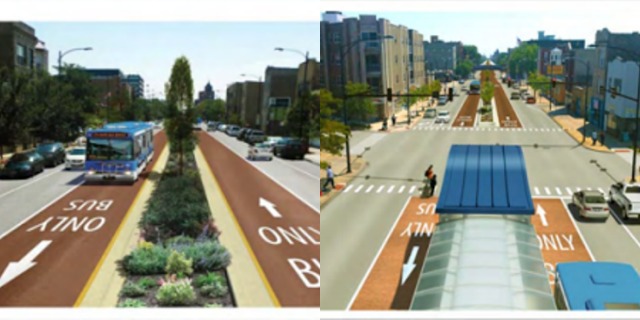CTA Releases Environmental Impact Assessment Regarding Ashland Avenue Bus Rapid Transit Project
By Lisa White in News on Nov 22, 2013 10:40PM

Ashland BRT rendering courtesy of CTA
An environmental impact assessment of the proposed Ashland Avenue Bus Rapid Transit project by CTA shows the plan will cost $160 million but offer considerably faster travel along the Ashland bus route between Irving Park Road and 95th Street.
As DNAinfo Chicago points out, the express buses could run up to 83 percent faster than the current routes, which would be a big advantage for those that depend on the route. Ryan Griffin-Stegink, Communications Associate for the Metropolitan Planning Council, noted that one in four Chicagoans that live within walking distance of Ashland do not own a car and more than 10 million people use the Ashland Avenue bus annually—a number which is higher than some CTA rail lines. “By bringing rail-like speed, convenience and reliability to the Ashland corridor, BRT (bust rapid transit) does more than simply improve transit service. It improves access to jobs, schools, businesses and other destinations, ultimately improving quality of life for the city’s residents,” Griffin-Stegink said.
On the other end of the spectrum, DNAinfo also reports up to 12 percent of parking spots would be lost along the route and 13 of the 89 intersections along Ashland would operate at, according to the report, an “unacceptable level of service.” That includes the loss of left turns, an issue that the city is actively looking at ways to avoid.
Many people, especially residents in the highly populated West Town area, have voiced concerns about losing parking along Ashland, the loss of a traffic lane and the issues regarding left turns on the street. But there are proponents; more than 2,500 people have signed a petition created by the Active Transportation Alliance in support of the project. “Residents, businesses and organizations that have signed on are supportive of BRT on Ashland because we need to rethink how we’re using limited street space to create safer streets that better serve all Chicagoans,” says Ted Villaire, Communications Director for Active Trans.
A July 2013 survey commissioned by the Rockefeller Foundation revealed more than 59 percent of Chicagoans surveyed about bringing bus rapid transit to Chicago supported the idea. And 73 percent agreed that they would take bus rapid transit instead of driving if it did make their commute faster.
Assuming the city figures out the logistics, especially in regards to the left turn situation, the Ashland Avenue BRT plan would be an interesting test into seeing how bus rapid transit could be integrated into Chicago’s public transit landscape. If bus rapid transit could cut down on overall street congestion and increase ridership while decreasing transit time, it would be a worthwhile option in looking towards the future of public transit in Chicago.
If you’d like to share your own opinions on the Ashland Avenue Bus Rapid Transit Project, the CTA is holding two public meetings regarding the plan. The first is Dec. 10 at Benito Juarez Community Academy (1450 W. Cermak Rd.) from 6 p.m. to 8 p.m. and Dec. 11 at the Pulaski Park Fieldhouse (1419 W. Blackhawk St.) from 6 p.m. to 8 p.m. If you can’t attend either meeting, you can email in your comment to AshlandBRT@transitchicago.com.